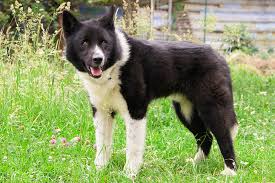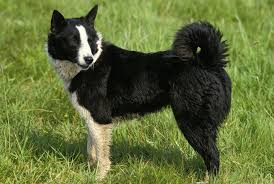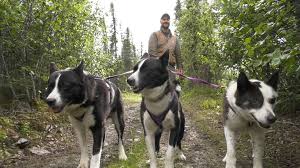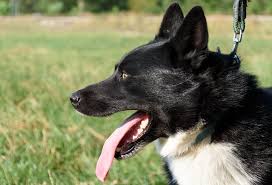The Karelian Bear Dog, also known as the Karjalankarhukoira, is a remarkable breed renowned for its hunting skills and unwavering loyalty. Originating from the Karelia region of Finland and Russia, this medium-sized spitz-type dog has gained popularity not only as a versatile working dog but also as a loving companion.
With its distinctive appearance and robust physique, the Karelian Bear Dog exudes strength and agility. They have a well-muscled body, a deep chest, and a dense double coat that provides excellent protection against harsh weather conditions. The coat comes in a variety of colors, most commonly black with white markings, giving them a striking and elegant appearance.
One of the most notable traits of the Karelian Bear Dog is its exceptional hunting abilities. Historically, these dogs were bred for hunting large game, including bears and elk.
They possess an incredible sense of smell, acute hearing, and remarkable endurance, making them highly effective in tracking and pursuing prey. This breed’s hunting instincts are deeply ingrained, and they excel in working independently or as a team with other dogs.
Despite their hunting background, Karelian Bear Dogs can also make wonderful family pets when properly trained and socialized. They are intelligent, quick learners, and highly adaptable to various environments.
Early socialization is crucial to ensure they get along well with other pets and children. This breed thrives on mental and physical stimulation, so regular exercise, such as brisk walks or engaging play sessions, is essential to keep them happy and fulfilled.
Karelian Bear Dogs are known for their unwavering loyalty and protective nature towards their families. They form strong bonds with their owners and are always ready to defend them if necessary. While they can be reserved and aloof with strangers, they are generally not aggressive unless provoked or perceive a threat to their loved ones.
Being a working breed, Karelian Bear Dogs require regular mental and physical challenges to prevent boredom and destructive behavior. Engaging them in activities like obedience training, scent work, or agility training can channel their energy and provide them with a sense of purpose. They thrive in homes with active individuals or families who can provide them with ample exercise and mental stimulation.
In terms of grooming, the Karelian Bear Dog’s thick double coat requires regular brushing to maintain its condition and remove loose fur. They shed seasonally and may require additional brushing during those times to manage the shedding. Beyond regular grooming, this breed is relatively low maintenance, with no specific health issues associated with the breed.
In addition, the Karelian Bear Dog is a remarkable breed that possesses a unique combination of hunting prowess and loyal companionship. Their intelligence, loyalty, and physical abilities make them excellent working dogs, while their affectionate nature and adaptability also make them cherished family pets. With the right training, socialization, and an active lifestyle, the Karelian Bear Dog can thrive and bring immeasurable joy to their owners’ lives.
Read Also: Categorization, Damages Caused, Diagnosis and Control Methods of Plant Diseases
History and Origin of Karelian Bear Dogs

The history and origin of the Karelian Bear Dog can be traced back to the Karelia region, which spans parts of Finland and Russia. This breed has a long lineage and has been developed over centuries for its hunting prowess, particularly in tracking and confronting large game such as bears and elk.
The exact origins of the Karelian Bear Dog are not well-documented, but it is believed to have descended from ancient northern spitz-type dogs that were used for hunting purposes by the indigenous people of the region. These dogs were highly valued for their ability to hunt and protect their human companions.
Throughout history, the Karelian Bear Dog played a vital role in the lives of the Karelian people, who depended on hunting for survival. The breed’s primary purpose was to track and hold large game at bay until the hunter arrived. Their tenacity, agility, and fearlessness in confronting dangerous prey made them indispensable in the harsh and challenging environment of the northern forests.
The first written records mentioning the Karelian Bear Dog date back to the 17th century. These records describe the dogs’ hunting skills and their integral role in assisting hunters. The breed gained recognition and popularity not only in its native region but also among hunting enthusiasts in other parts of Finland and Russia.
In the early 20th century, efforts were made to establish breed standards and preserve the Karelian Bear Dog’s unique qualities. In 1945, the Finnish Kennel Club officially recognized the breed, and the first breed standard was established. The breed standard was revised and refined over time to maintain the distinctive characteristics of the Karelian Bear Dog.
While the breed has primarily been used for hunting, its popularity as a companion and working dog has grown in recent years. Karelian Bear Dogs have been utilized in search and rescue operations, as therapy dogs, and in various dog sports. They continue to demonstrate their remarkable abilities, adaptability, and loyalty in various roles, showcasing their versatility beyond the hunting field.
Today, the Karelian Bear Dog remains a treasured breed, both in its native region and around the world. It has gained recognition from major kennel clubs, including the American Kennel Club (AKC) and the United Kennel Club (UKC), which now recognize the breed.
Despite its relatively small population, efforts are being made to preserve and promote the breed, ensuring its continued existence and appreciation for generations to come.
Health Issues and Lifespan of Karelian Bear Dogs

The Karelian Bear Dog is generally a healthy breed with no specific breed-related health issues. However, as with any dog breed, they can be susceptible to certain health conditions.
It’s important for potential owners to be aware of these conditions and take appropriate measures to ensure their dog’s well-being. Regular veterinary check-ups, a balanced diet, exercise, and maintaining a healthy weight are all crucial for promoting good health in Karelian Bear Dogs.
While not exclusive to the breed, some health issues that Karelian Bear Dogs may potentially experience include:
Hip Dysplasia: This is a common condition in many dog breeds. It occurs when the hip joint doesn’t develop properly, leading to degeneration and arthritis. Responsible breeders often screen their breeding dogs for hip dysplasia to reduce the incidence in the breed.
Progressive Retinal Atrophy (PRA): PRA is a group of degenerative eye diseases that lead to progressive vision loss and, in some cases, blindness. Regular eye examinations by a veterinary ophthalmologist can help detect and manage PRA.
Allergies: Like many other breeds, Karelian Bear Dogs can be prone to allergies, which can manifest as skin irritation, itching, or gastrointestinal issues. Identifying and avoiding allergens or providing appropriate treatment under veterinary guidance can help manage allergies.
The average lifespan of a Karelian Bear Dog is typically between 10 and 14 years. Providing proper nutrition, regular exercise, mental stimulation, and routine veterinary care are essential for maximizing their lifespan and overall well-being.
It’s worth noting that individual dogs may vary, and not all Karelian Bear Dogs will experience these health conditions. Responsible breeding practices, including health screenings of the parent dogs, can significantly reduce the risk of hereditary health issues in puppies.
If you’re considering getting a Karelian Bear Dog, it’s advisable to research reputable breeders who prioritize health testing and have a good understanding of the breed’s genetic health. Additionally, maintaining a healthy lifestyle for your dog through a balanced diet, regular exercise, and routine veterinary care can help ensure they live a long and healthy life.
Read Also: Fertilizer Application, Pests and Diseases Control in Cocoa
Karelian Bear Dog Breed Complete Grooming and Care Guide

The Karelian Bear Dog has a double coat that requires regular grooming to keep it in good condition and minimize shedding. Here is a complete grooming and care guide for your Karelian Bear Dog:
Brushing: The dense double coat of the Karelian Bear Dog should be brushed regularly to remove loose hair, prevent matting, and maintain the coat’s health. A slicker brush or a medium-toothed comb is recommended for this breed.
Brushing should be done at least once a week, but during the shedding season, more frequent brushing may be necessary to manage the increased hair loss.
Bathing: The Karelian Bear Dog has a self-cleaning coat and does not require frequent bathing unless they get excessively dirty or have a strong odor. Use a gentle dog shampoo and thoroughly rinse the coat to remove all traces of soap. Over-bathing can strip the coat of its natural oils, leading to dry skin and a dull coat.
Nail Care: Regular nail trimming is essential for the comfort and health of your Karelian Bear Dog. Long nails can cause discomfort and potentially lead to joint and posture problems. Trim the nails carefully using a dog nail clipper or grinder.
Be cautious not to cut into the quick, which is the sensitive part of the nail that contains blood vessels. If you’re unsure, consult a professional groomer or veterinarian for assistance.
Ear Cleaning: Check your dog’s ears regularly for signs of infection, such as redness, swelling, or discharge. Clean the ears gently with a veterinarian-recommended ear cleaner and a soft cloth or cotton ball.
Avoid inserting anything deep into the ear canal, as it can cause injury. If you notice persistent ear problems, consult your veterinarian for appropriate treatment.
Teeth Cleaning: Dental care is important for your dog’s overall health. Regularly brush your Karelian Bear Dog’s teeth with a dog-friendly toothpaste and toothbrush. This helps prevent tartar buildup, gum disease, and bad breath. Additionally, providing dental chews or toys designed to promote oral health can be beneficial.
Exercise and Mental Stimulation: Karelian Bear Dogs are active and intelligent dogs that require regular exercise and mental stimulation. Engage them in activities such as brisk walks, jogging, hiking, or interactive play sessions.
Mental stimulation can be provided through puzzle toys, obedience training, scent work, or agility exercises. Providing adequate exercise and mental enrichment helps keep your dog physically fit, mentally stimulated, and prevents behavioral issues.
Regular Veterinary Check-ups: Schedule regular veterinary check-ups for your Karelian Bear Dog. These visits allow the veterinarian to monitor your dog’s overall health, administer necessary vaccinations, and address any concerns or potential health issues early on.
Regular preventive care is essential to ensure your dog’s well-being and catch any health problems before they become serious.
Remember to provide your Karelian Bear Dog with a balanced and nutritious diet suitable for their age, size, and activity level. Fresh water should always be available. Finally, shower your dog with love, attention, and positive reinforcement to foster a strong bond and a happy, well-adjusted companion.
By following these grooming and care guidelines, you can keep your Karelian Bear Dog healthy, comfortable, and looking their best.
Read Also: Collective Farming: The Key to Sustainable Food Systems






